
|
|
Abstract: Text and photos of the history of Bahá'í activities in Burma and Myanmar, 1878-1995. Notes: Originally posted at thebahaifaith-myanmar.com [archive.org]. Edited and reformatted for posting here. Photos might not be correctly identified, as the original site did not provide captions. |
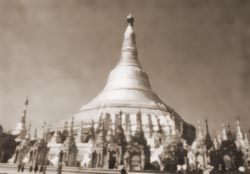 1. A pagoda in Myanmar
|
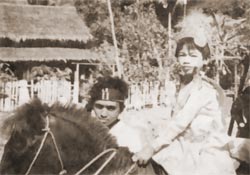 2. (not identified)
|
 3. Buddhist child
|
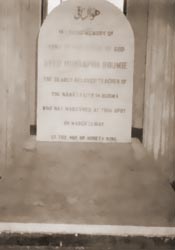 4. Gravesite of Moustafa Roumi
|
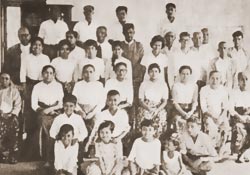 5. Visit of Roumi
|
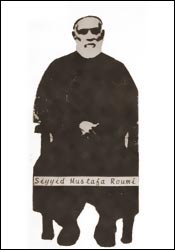 6. Seyyed Mustafa Roumi
|
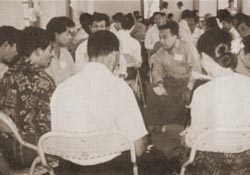 7. Annual convention, 1995
|
 8. Visit of Roumi
|
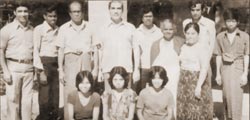 9. Visit of Roumi
|
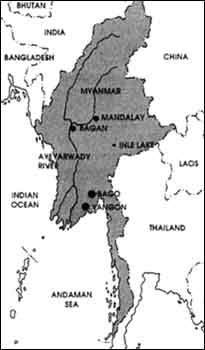 10. "Kite and string" map
|
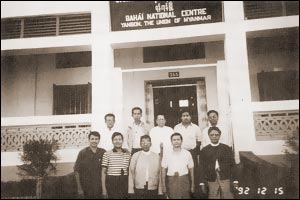 11. National Convention in Daidenaw
|
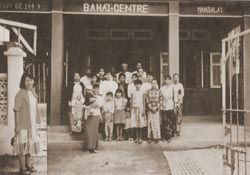 12. Mandalay
|
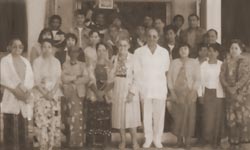 13. A Burmese wedding
|
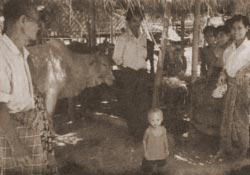 14. Children of Myanmar
|
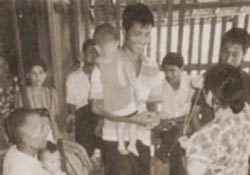 15. (not identified)
|
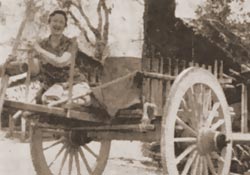 16. Abdu'l-Bahá's Village
|
 17. A Burmese wedding
|
 18. (not identified)
|
 19. Visit of Counsellor Schwerin
|
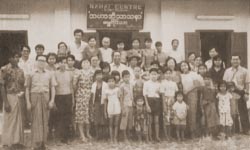 20. Daidenaw
|
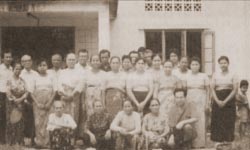 21. Twante
|
 22. Twante
|
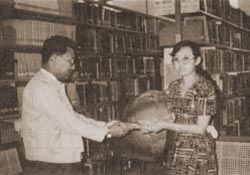 23. U Winn Hlaing presenting The Bahá'í Faith to the librarian of Distant University.
|
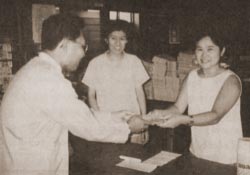 24. (not identified)
|
 25. Annual convention, 1995
|
Introduction
I had the good fortune to visit the country periodically over the past two decades, even back when when it was called Burma.
Today, Myanmar is opening up to the outside world. Modern skyscrapers run parallel to the steeples of the Pagodas.
Myanmar is a country for the traveler. Tourists may come and go. But when the traveler gets involved with the Myanmars, sees their way of life, kindness and hospitality, fascination remains forever.
It therefore gives me great pleasure to be able to write brief historical events of the Bahá'í Faith in this wonderful country, which I dedicate to all Myanmar Bahá'ís. The religion goes back to the days of Bahá'u'lláh's Ministry. Today, there are more than 20,000 Bahá'ís scattered throughout the land.
I would point our, however, that I have not written in any chronological order. I hope this will be a stimulus. In future, some Baha's friends may want to set the records straight and do a more detailed job.
Nevertheless, I hope this booklet will give some insight of the colourful lives of the Myanmar friends, those who have visited the country and others who have yet to come.
— (Counsellor) Rose Ong
Myanmar
Burma ages with mystery, unperturbed by any transformation of the world beyond its borders. Its most visible change is its name.
In 1989, Burma was renamed Myanmar, which means "first inhabitants in the world." And those first inhabitants have preserved their original ways and lifestyle by isolating themselves from the rest of the world.
When you stare at a map of this country, a "kite and its string" may appear [see picture #10], the sting being the Ayeyarwady (Irrawaddy) River which controls the kite, Myanmar.
Ayeyarwady and its tributaries hold the life-blood of the land. It rises in the southern Himalayas and traverses the country from north to south before emptying into the Andaman Sea.
There are altogether 135 groups of nationalities which have been coexisting with one another: Kachin, Kaya, Kayin, Chin, Bharmar, Mon, Rakhine and Shan are regarded as the major groups. Among them, Bharmar is the majority — 69% of the total population.
Every group of nationality speaks its own language or dialect. But the official language is Myanmar, which is spoken all over the country. English is also spoken and understand especially in the cities like Yangon and Mandalay.
Religion
It has often been said that Myanmar is the most profound Buddhist country in the world.
Myanmar Buddhism is Theravada or Hinayana Buddhism, that sect of Buddhist adhering to the Buddha's original teaching, and the dominant form of Buddhism throughout South-east Asia.
As 80% of about 50 million population are Buddhists. Monks, young and old, temples and pagodas, are a common sight in Myanmar.
The most important moment in the life of a young Myanmar boy is that of his shin-pyu, his initiation as a novice in the order monks. Every young boy is supposed to become a novice monk for a few weeks in his life.
There are about 800,000 monks in Myanmar. The pongyi (monk) can leave the order any time but about 100,000 have dedicated their entire lives to the Sangha, a Buddhist brotherhood, in a renunciation of the world.
Before and after shin-pyu, the boy is dressed in princely garments of silk, wears a golden headdress, and sits on a horse on parade. These objects symbolize the worldly goods which the novice monk must renounce.
How the Bahá'í Faith Came to Burma (historical footnote on Siyyid Mustafa Roumi)
The first Bahá'í teacher sent by Bahá'u'lláh to India and Burma was Jamal Effendi. He arrived in India in 1876 and met Siyyid Mustafa Roumi's family, who were settled in Madras.
When Jamal Effendi left Madras, Siyyid Mustafa Roumi, who was in his early twenties, was so attracted by the Faith that he decided to accompany Jamal Effendi and traveled with him throughout India and Burma.
Both men arrived in Rangoon in 1878, after seven days of hard journey by steamer. The news of their travel had been widely spread because of the difficulties they faced with their luggage. Not only were the police notified but all the citizens of Rangoon heard of them. Amongst the many people who came to the wharf to meet them was a young man named Haji Siyyid Mahdi Shirazi of Egypt.
Jamal Effendi and Siyyid Mustafa Roumi stayed in an adjoining business quarters in Mogul Street (now Shwebonthar Street). Soon, people of different nationalities and creeds came daily to listen to their teachings.
Even the Chief Commissioner gave them a warm reception and heard their statements. Later, the Chief Commissioner gave them a letter of Introduction to the Chief Secretary, Mr. J E Bridges, who extended Jamal Effendi and Siyyid Mustafa Roumi a cordial interview.
Many followers from the Sunnite and Shi'ite communities were attracted to the teaching — thus forming the largest Bahá'í group in Rangoon. They received many Tablets from Bahá'u'lláh and Abdu'l-Bahá. From this community, Siyyid Mustafa Roumi and some Bahá'ís made their pilgrimage to Haifa in 1899. They brought with them the sacred marble sarcophagus, made in Mandalay, for His Holiness, the Bab, which was placed in the Tomb of the Bab on Mount Carmel.
After the Faith was firmly established in Rangoon, both Jamal Effendi and Siyyid Mustafa Roumi left for Mandalay. It was the capital of Burma and the Burmese king lived there.
It took them ten days to reach Mandalay. They stayed in "Joon Palli" (a mosque) for the night. Then, a young man name Ko Thwin, who heard of Jamal Effendi and his spiritual teaching carried the news to his uncle, Abdu'l-Sattar (in Burmese U Koo). The latter was a well-known silk merchant and a man of great intelligence and influence in his circle.
Jamal Effendi and Siyyid Mustafa Roumi Stayed in U Koo's house and met many friends. Soon, this meeting-house on 33 Street, between 83 and 84 Street, Mandalay, became the centre which attracted many sincere and devoted audience. This was the beginning of the Divine Cause of Bahá'u'lláh in Mandalay. U Koo and his nephew became the first believers in Mandalay.
Both men stayed in Mandalay for eighteen months. They had to return to Rangoon to earn their living. Roumi was sent with some ponies and jewellery to Calcutta. He returned with great profit. On another trip with the same kind of livestock and gems he traveled to Penang in the Malay peninsula.
"Work is Worship and Service is Prayer" was their motto. They decided to open a pony market which proved quite successful and profitable.
Later, Jamal Effendi decided to leave for India. Siyyid Mustafa Roumi settled in Burma and married a Burmese lady, Daw Myaing.
In 1942, when the Japanese invaded Burma, most of the Bahá'ís of Mandalay and Rangoon took refuge in Daidenaw — Abdu'l-Bahá village.
Shoghi effendi in a letter dated 10 November, 1945, written on his behalf, described the condition of the Burmese Bahá'ís at the end of World War II. The letter states:
" . . . the Burmese Bahá'ís . . . have lost almost everything, including Bahá'í institutions destroyed and, above all, their wonderful pioneer-teacher, Siyyid Mustafa Roumi, was cruelly murdered by Burmese villagers together with a number of other Bahá'ís. But they have gathered in their ruined village, and with the utmost faith and devotion are seeking to rebuild their Baha' institutions; they have already started their school and elected their Assembly. Such evidences of the deep attachment of Bahá'ís to their religion are, indeed, inspiring! . . ."
Siyyid Mustafa Roumi was killed on 13 March 1942. The title of Hand of the Cause of God was bestowed on him, posthumously, by Shoghi Effendi on 14 July, 1945, in a cable addressed to the National Spiritual Assembly of India and Burma.
Daidenaw — Abdu'l-Bahá Village
Daidenaw is a very small and seemingly insignificant village in the district of Kungyangoon in Burma. The whole village stretches a few miles on either side of a trunk road that runs through countless other similar villages. What makes it different to people passing by, is the unexpected and striking white brick double-storeyed shrine of Mustafa Roumi, an outstanding proclamation of the Love and respect that the Bahá'ís have for the man who brought them the Faith.
The remarkable story of how it happened is all the more remarkable when one discovers that it began through a simple act of kindness by a Bahá'í to a stranger. The story began long ago in a courthouse in Rangoon when two villagers who had come from Daidenaw with some legal problem, found themselves stranded because they had no friends in Rangoon to stand security for them.
Abdul Kareem, a Bahá'í of Rangoon who happened to be in the courtroom that day, saw their plight and offered his assistance. He not only stood bail for them but extended them hospitality in his home, and also gave them the greatest gift of all: the message of Bahá'u'lláh. They were very interested so he took them to meet a Bahá'í friend, Siyyid Mustafa Roumi and they invited him to visit Daidenaw to tell the rest of the village about Bahá'u'lláh. This of course, he was very happy to do. He made many trips there, and the whole village became Bahá'í making Daidenaw one of history's first all-Bahá'í village. This took place during the time of Abdu'l-Bahá who was so happy to hear of it that he referred to Daidenaw as His village.
National Convention in Daidenaw
Ridvan 1974 was a very special time for the Bahá'ís of Burma, for beloved Amatu'l-Baha Ruhiyyih Khanum was present at their convention. It was held in Daidenaw especially in her honour as she had expressed a wish to visit this historic village.
Speaking to an audience of about 300 Bahá'ís ranging from tiny children to venerable old men and women, Ruhiyyih Khanum said that as a little girl in Montreal, she could remember being told about a village in Burma where all the people were Bahá'ís, and it had been one of her greatest wish to go there and meet them. Violet Nakhjavani, who accompanied Amatu'l-Baha, added that as far as she could remember, the Bahá'ís in Iran also used to tell stories of "Abdu'l-Bahá's village" in the heart of Burma.
Whilst session of the convention were on, Ruhiyyih Khanum, dressed in native costume, and with flowers in her hair, walked around the small village with some of the friends, learning about the customs of the place.
First Youth Conference ‘74
The Bahá'í youths of Burma had invited participants from eleven countries to their first youth conference held immediately after the Convention.
Only one youth representative from Malaysia attended — Miss Padma Sundram.
Befriending the Chinese in Myanmar
Trip to Myanmar (Burma) 26 — 30 Apr 1990
By Foo Chek Woo
"As I would only be meeting Counsellor later that evening, I was struggling as to what to do during the day. There are only 2 or 3 presentable hotels in the whole of Yangon hence many weddings are held there everyday. Apparently everyone was trying to get married before Vesak Day. According to Burmese beliefs, all the gods will be fasting for the next 4 months and no blessing will be showered on the married couple during this period. I decided to drop into one wedding that was taking place. The names of the couple on the board were typically Burmese but the parents who were waiting by the doorway to welcome the guests were typically Chinese in appearance. I decided to go up to them and congratulate them in Mandarin. They were surprised but soon started talking and the other relatives joined in. By the time the wedding ceremony was about to begin. I had been invited to the reception and was given permission to take as many photographs as I like [see picture #17]. The main dialect group is Hokkien. The older generation can all converse in Mandarin. Some of the younger generation are also conversant in Madarin and Hokkien, especially among the well-to-do families. They may turn out to be useful contacts in the future."
Mandalay
The Bahá'ís of Mandalay often complain that visitors only go to Yangon, and of course, their favourite spot is Daidenaw, Abdu'l-Bahá Village.
In November 1994, Counsellors Nobuko Iwakura and Rose Ong visited Mandalay. Subsequently, Mr. Hassan Sabri, who is attached to the Office of Social and Economic Development in Haifa and his wife, made a trip there in February, 1995. They were followed by Ms Virginia Harden and Dr Mariam Lawyer. In April 1995, International Teaching Center Member, Counsellor Kimiko Schwerin, made a special visit to Mandalay.
Visit of International Teaching Centre Member, Counsellor Kimiko Schwerin — 17-22 June 1995
Health Care Project Launched in Aung Thu Kha Village
Under the thatched roof of a Bahá'í home in Aung Thu Kha Village, some 100 km from Yangon, Consellor Kimiko sat fanning herself. The sun blazed hotly outside. Counsellor Rose Ong, her two Singapore friends, Daniel Chu, Ng Swee Huat and sister, Mrs Theresa Chee from Ipoh, Malaysia, were also present.
The project was mooted by Counsellors Nobuko Iwakura and Rose Ong during their last visit in November, 1994. It was therefore timely to launch this project during Counsellor Kimiko's visit. She kindly agreed simple the occasion. Some medicines, posters showing simple healthy ways to follow, were explained to the villagers. Bahá'í posters and Bahá'í identity medals were also given.
Later, we went to Okpho, where Auxiliary Board Member, U Aung Kyi lives. His house is opened to everyone, Bahá'ís and enquirers alike.
Before we returned to Yangon, we visited a remote out of the way village. We were amazed to see a beautiful white building — it was the Bahá'í Centre, Kyet Su Daw.
Daidenaw — We visited Daidenaw the next day. The Bahá'ís turned out in troops. They sat patiently and listened to Counsellor Kimiko's talk. She spoke fervently of life in Haifa and told the friends to pray daily, read the Holy Writings, teach, contribute and Live the life.
Visit of International Teaching Centre Member, Counsellor Kimiko Schwerin — 17-22 June 1995Health Care Project Launched in Aung Thu Kha Village
Under the thatched roof of a Bahá'í home in Aung Thu Kha Village, some 100 km from Yangon, Consellor Kimiko sat fanning herself. The sun blazed hotly outside. Counsellor Rose Ong, her two Singapore friends, Daniel Chu, Ng Swee Huat and sister, Mrs Theresa Chee from Ipoh, Malaysia, were also present.
The project was mooted by Counsellors Nobuko Iwakura and Rose Ong during their last visit in November, 1994. It was therefore timely to launch this project during Counsellor Kimiko's visit. She kindly agreed simple the occasion. Some medicines, posters showing simple healty ways to follow, were explained to the villagers. Bahá'í posters and Bahá'í identity medals were also given.
Later, we went to Okpho, where Auxiliary Board Member, U Aung Kyi lives. His house is opened to everyone, Bahá'ís and enquirers alike.
Before we returned to Yangon, we visited a remote out of the way village. We were amazed to see a beautiful white building — it was the Bahá'í Centre, Kyet Su Daw.
Daidenaw — We visited Daidenaw the next day. The Bahá'ís turned out in troops. They sat patiently and listened to Counsellor Kimiko's talk. She spoke fervently of life in Haifa and told the friends to pray daily, read the Holy Writings, teach, contribute and Live the life.
Twante — Our next stop was Twante. Everywhere we went the reception we received was overwhelming. Credit must be given to the Children's Class teachers. The children are well-behaved and respectful, and certainly the future of the Bahá'í community of Myanmar.
Bumper Activities in Myanmar — 1995
More than 700 People Enrolled Under the Banner of Baha
A successful 3-day teaching campaign was held in Twante from 31 January to 2 February. More than 50 participants took part in this project, organized by the National Teaching Committee. A total of 16 new localities were opened up and 340 souls declared their faith in the Cause the dwellers of Yedwingon village became Bahá'ís.
From 15 to 21 March, the National Teaching Committee again organized a teaching trip to Aungban, Shan State. Seventeen believers participated and more than 117 souls enrolled.
The National Bahá'í Youth Committee also organized a successful teaching campaign in the Nyaungon, Yangon Division. It was held from 17 to 18 March. 60 volunteers helped to open 16 new localities and 255 new souls became Bahá'ís.
(Reported by the National Spiritual Assembly, Myanmar)
In another quieter scene in April 1995, U Winn Hlaing and some Bahá'ís visited four universities. Here, U Winn Hlaing presented a Bahá'í book to the Librarian, University of Economic, Yangon.
Comment: It would appear that activities were only geared up during 1994-1995. This is not true, the whole Bahá'í community, various Bahá'í Committees under the supervision of the National Spiritual Assembly, Myanmar, together with Auxiliary Board Members and assistants, were always actively involved. The set-back was the not much publicity was made known abroad.
Heartiest congratulations to the National Teaching Committee, the National Bahá'í Youth Committee and, to U Winn Hlaing for the photographs of the lovely lady-librarians, when he presented them Bahá'í books.
37 Annual Bahá'í convention 30 Apr 2 May 95
Downstairs, the tables were laid out for everyone present to enjoy their meals. Children took their turns to eat quietly. It was like a big family gathering. Friends who have not met, kept with each other's news. Gunny sacks of rice, other local eatables and cash donation were received.
The program was well-planned with a question-and-answer session. Delegates formed groups to consult on varied topics which included expansion and consolidation. Women delegates took turns to speak out their minds. The high-light of the evening session was the prize-giving ceremony for children — they were graded on attendances, behaviour, reciting of prayers etc. More than seventy children from all over the country came to receive his/her prize eagerly.
The Myanmar friends treat Ridvan as the King of Festivals and, an occasion, not to be missed. It was also an experience for my sister, Singapore friend and I, to witness their spirit and devotion to the Cause of Bahá'u'lláh.
Children of Myanmar
Children are indeed the ‘gems' and the future of the Bahá'í community. An equally older ‘gem' is Dr Mariam Lawyer. A talented Bahá'í teacher, Mariam has been in-and-out of Myanmar for the past fifteen years. She demonstrates puppet-princess story at the Bahá'í Centre in Yangon (April 1995). “The Princess sought to find her own husband against her father's wishes . . . “Everyone, young and old, enjoyed Aunty Mariam's story.
First Teacher's Training Course — 8-18 May 1995
Bahá'í Centre, Yangon.
At the initiation of Mr. Hassan Sabri of the Office of Social and Economic Development, Haifa, Mrs. Addis Fryback of Macau, visited Myanmar.
Thirty-two students from fifteen communities were present as well as Members of the National Assembly, Auxiliary Board Members and Social and Economic Committee members.
U Tun Yi, Vice-Chairman, National Assembly, Myanmar, welcomed Mrs. Fryback for coming all the way to conduct this course. The sessions were from 8.30 am to 5.00 pm daily. The untiring efforts of Mrs. Fryback gave those who attended and, especially, the Children's Class teachers a better understanding of imparting knowledge to the children.
At nights there were audio-visual and general knowledge. Dr U Ye Mya, Dr U Kyaw Myint Maung, Dr U Kyaw Naing Oo, medical students Mg Kyaw Swa, Mg Soe Thant and Health Assistant U Soe Win shared their knowledge on health.
On 18 May, Mrs. Fryback demonstrated practical ways of teaching. Fifty children from Yangon, North and South Okkalapa were invited. Whilst the teachers taught the children, Mrs Fryback supervised and later reviewed their work.
The session ended successfully with a closing speech by U Kyaw, Chairman of National Assembly. There were exchange of gits as students thanked Mrs Fryback, Certificates and Teacher's Guide in Myanmar were also given to the students.
Mrs Fryback visited North and South Okkalapa, Daideaw and Twante to meet and inspire the friends.
(Reported by National Assembly, Myanmar 31 May 1995)
Travel Out of Myanmar
1992 - U Tun Yi National Assembly Member
- U Tin Shwe Auxiliary Board Member
- Daw Tin Tin Yi Local Spiritual Assembly, Mandalay
Were invited by the Universal House of Justice to the Holy Land, Haifa, for the Centenary of Bahá'u'lláh. They stopped over in Bangkok and later visited Singapore.
1993 - U Shwe Mann Secretary, National Assembly Member
- U Shwe Thee Treasurer
- U Winn Hlaing Asst. Secretary
Were invited to Haifa for the Election of the Universal House of Justice. Subsequently, they traveled to India.
1994 - U Tin Shwe, Auxiliary Board Member, was able to attend the Asian Youth Conference in Bangkok. He traveled around Thailand and Malaysia after the Conference.
The Bahá'í Cemetery in Yangon
The Bahá'í cemetery in Yangon was requisitioned by Government. In exchange, another plot of land was allocated to the Bahá'ís. The deadline for removal of the dead remains of Bahá'í was April, 1995.
|
|